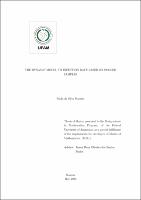| ???jsp.display-item.social.title??? |


|
Please use this identifier to cite or link to this item:
https://tede.ufam.edu.br/handle/tede/8167Full metadata record
| DC Field | Value | Language |
|---|---|---|
| dc.creator | Martins, Paola da Silva | - |
| dc.creator.Lattes | http://lattes.cnpq.br/9613601561308034 | por |
| dc.contributor.advisor1 | Santos Júnior, James Dean Oliveira dos | - |
| dc.contributor.advisor1Lattes | http://lattes.cnpq.br/0606640600434171 | por |
| dc.contributor.referee1 | Rifo, Laura Leticia Ramos | - |
| dc.contributor.referee1Lattes | http://lattes.cnpq.br/7294003699266180 | por |
| dc.contributor.referee2 | Gonçalves, Kelly Cristina Mota | - |
| dc.contributor.referee2Lattes | http://lattes.cnpq.br/1715326722961736 | por |
| dc.date.issued | 2020-05-08 | - |
| dc.identifier.citation | MARTINS, Paola da Silva. The dynamic model to infection rate based on pooled samples. 2020. 56 f. Dissertação (Mestrado em Matemática) - Universidade Federal do Amazonas, Manaus, 2020. | por |
| dc.identifier.uri | https://tede.ufam.edu.br/handle/tede/8167 | - |
| dc.description.resumo | In this thesis we will work on the real time estimation of infection rates in vectors. It uses the dynamic generalized linear model to estimate the rate of infection of theses vector that are put in different pools sizes. The proposed methodology used the data of the mosquitoes tested weekly during the months of June through October referring to the period of 2012 to 2019. These mosquitoes were taken from the Department of Health from Rhode Island, in the United States. The model found had a good adherence to the aforementioned data. | por |
| dc.description.abstract | In this thesis we will work on the real time estimation of infection rates in vectors. It uses the dynamic generalized linear model to estimate the rate of infection of theses vector that are put in different pools sizes. The proposed methodology used the data of the mosquitoes tested weekly during the months of June through October referring to the period of 2012 to 2019. These mosquitoes were taken from the Department of Health from Rhode Island, in the United States. The model found had a good adherence to the aforementioned data. | eng |
| dc.description.sponsorship | * | por |
| dc.format | application/pdf | * |
| dc.thumbnail.url | https://tede.ufam.edu.br//retrieve/44501/Disserta%c3%a7%c3%a3o_PaolaMartins_PPGM.pdf.jpg | * |
| dc.language | eng | por |
| dc.publisher | Universidade Federal do Amazonas | por |
| dc.publisher.department | Instituto de Ciências Exatas | por |
| dc.publisher.country | Brasil | por |
| dc.publisher.initials | UFAM | por |
| dc.publisher.program | Programa de Pós-graduação em Matemática | por |
| dc.rights | Acesso Aberto | por |
| dc.subject | Dynamic linear models | eng |
| dc.subject | Infection rates in vectors | eng |
| dc.subject | Arbovirus | eng |
| dc.subject | Disease control | eng |
| dc.subject | Epidemiological control | eng |
| dc.subject.cnpq | CIÊNCIAS EXATAS E DA TERRA | por |
| dc.title | The dynamic model to infection rate based on pooled samples | por |
| dc.type | Dissertação | por |
| dc.contributor.advisor1orcid | https://orcid.org/0000-0002-0627-6126 | por |
| dc.contributor.referee1orcid | https://orcid.org/0000-0002-1579-8073 | por |
| dc.subject.user | Dynamic Generalized Linear Model | eng |
| dc.subject.user | West Nile | eng |
| dc.subject.user | Beta Distribution | eng |
| dc.subject.user | Disease | eng |
| dc.subject.user | Empirical Bayes | eng |
| Appears in Collections: | Mestrado em Matemática | |
Files in This Item:
| File | Description | Size | Format | |
|---|---|---|---|---|
| Dissertação_PaolaMartins_PPGM.pdf | Dissertação_PaolaMartins_PPGM | 849.52 kB | Adobe PDF |  Download/Open Preview |
Items in DSpace are protected by copyright, with all rights reserved, unless otherwise indicated.




